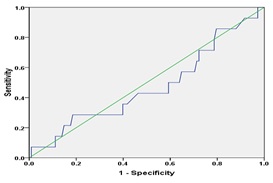Pre-treatment de-ritis ratio as a marker for cervical cancer: a study at regional cancer centre
Abstract
Background: The role of AST/ALT ratio in prognostication of cancer cervix is not established in different study settings except for very few where they have highlighted on circulation of higher levels of AST and ALT in the cervical cancer patients. Moreover, there is a biological plausibility explained in one of the studies hence the study was conducted to elicit if the AST/ALT ratio could predict the prognosis of advanced cancer cervix before the initiation of treatment.
Methodology: A follow up study was conducted among 122 newly diagnosed locally advanced carcinoma cervix patients in a regional cancer centre Bangalore from June 2015 to May 2018. All the basic data, normal and abnormal levels of serum Aspartate transaminase (AST), Alanine transaminase (ALT) and AST/ALT ratio were collected, followed up for one year and compared for overall survival using Log-rank test along with Kaplan-Meir curves. Receiver Operator Characteristic curves (ROC curves) were plotted to determine the poor outcome (death). Data was analysed using SPSS 18.0 and P value < 0.05 was considered statistically significant.
Results: The mean age of the study participants was 50.4±10.6years. Mean follow up period was 4±3 months (1-12 months). Median serum AST, ALT and de-ritis ratio did not differ among the different stages of cervical cancer. Area under the curve (AUCs) for de-ritis ratio was found to be not significant with very poor accuracy (AUC = 0.47;P> 0.05). It was observed that there was no statistically significant difference between the groups in their survival rates.
Conclusion: AST/ALT ratio cannot predict the prognosis of advanced cancer cervix before the initiation of treatment.
Downloads
References
Kumar R. Prevalence of female reproductive tract cancer in a teaching hospital of Rohtas District, Bihar, India. Int J Res Med Sci2018;6(12):4058-62. doi: http://dx.org/10.18203/2320-6012.ijrms20184907
Srivastava S, Natu SM, Gupta A, et al. Lipid peroxidation and antioxidants in different stages of cervical cancer: Prognostic significance. Indian J Cancer. 2009 Oct-Dec;46(4):297-302. doi: http://www.indianjcancer.com/text.asp?2009/46/4/297/55549.
Antébi H, Mansoor O, Ferrier C, et al. Liver function and plasma antioxidant status in intensive care unit patients requiring total parenteral nutrition: comparison of 2 fat emulsions. JPEN J Parenter Enteral Nutr. 2004 May-Jun;28(3):142-8.DOI: https://doi.org/10.1177/0148607104028003142.
Botros M, Sikaris KA. The de ritis ratio: the test of time. Clin Biochem Rev. 2013 Nov;34(3):117-30.
Rief P, Pichler M, Raggam R, et al. The AST/ALT (De-Ritis) ratio: A novel marker for critical limb ischemia in peripheral arterial occlusive disease patients. Medicine (Baltimore). 2016 Jun;95(24):e3843. doi: https://doi.org/10.1097/MD.0000000000003843.
Chougule A, Hussain S, Agarwal DP. Prognostic and diagnostic value of serum pseudocholinesterase, serum aspartate transaminase, and serum alinine transaminase in malignancies treated by radiotherapy. J Cancer Res Ther. 2008 Jan-Mar;4(1):21-5.
Manju V, Balasubramanian V, Nalini N. Oxidative stress and tumor markers in cervical cancer patients. J Biochem Mol BiolBiophys. 2002 Dec;6(6):387-90. DOI: https://doi.org/10.1080/1025814021000036115
Veeramalla V. Pseudocholinesterase, aspartate transaminase, alanine transaminase as markers for cervical cancer: a study in a tertiary care hospital. Int J Adv Med. 2017;4(6):1557-61. doi: http://dx.org/10.18203/2349-3933.ijam20175134.
Thriveni K, James R, Krishnamoorthy L, Deshmane V. Serum Transaminases Ratio in Breast Cancer Patients. Austral - Asian J Cancer. 2009;8(4):199-201.
Li J, Wu MF, Lu HW, Zhang BZ, Wang LJ, Lin ZQ. Impact of hyperglycemia on outcomes among patients receiving neoadjuvant chemotherapy for bulky early stage cervical cancer.PloS one. 2016;11(11).doi: https://doi.org/10.1371/journal.pone.0166612.
Nyarota K, Zhou DT. Albumin and Total Protein in Cancer Patients at Radiotherapy Clinic, Zimbabwe.Saudi J. Med. Pharm. Sci.2017;3(10A):1071-1076. http://scholarsmepub.com/sjmps/.
Devi LI, Ralte L, Hmar L, Ali MA. Serum biochemical profile of patients suffering from cervical cancer in Mizoram. International Journal of Chemical Studies 2018;6(6): 883-886.
Huang H, Wang XP, Li XH, et al. Prognostic value of pre-treatment serum alanine aminotransferase/aspartate aminotransferase (ALT/AST) ratio and gamma glutamyltransferase (GGT) in patients with esophageal squamous cell carcinoma. BMC Cancer. 2017 Aug 14;17(1):544. doi: https://doi.org/10.1186/s12885-017-3523-y.



 OAI - Open Archives Initiative
OAI - Open Archives Initiative


